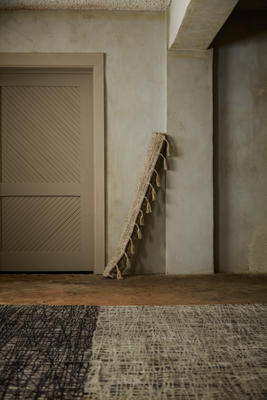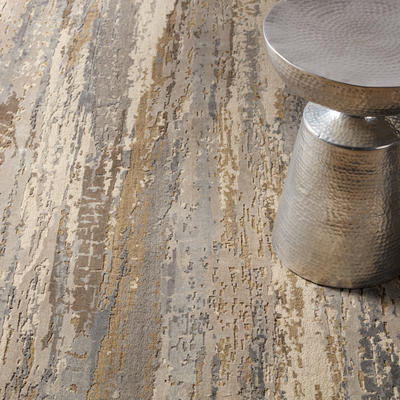How did your partnership with Jaipur Living come about?
Jaipur Living is our family business. My sister Asha is the CEO and founder of the U.S. division, Jaipur Living, and I am the design director of the Indian division, Jaipur Rugs. When I designed my first collection, it was a natural evolution for the brand to offer it to the Jaipur Living client base in America.
What is the starting point when you are designing your rug collections for Jaipur Living?
I went to college in the U.S., and I visited often after that for trade shows and customer meetings. I loved learning from retailers and interior designers how rugs can work in the interior space. Through the Kavi collections for Jaipur Living, I wanted to both bring my creative vision to rugs I thought would work in homes today and express my personal vision. Before I began designing my namesake collections, I created a lot of rugs based on client feedback. At the time, I was new to rugs, so I did not have a clear outlook of my own. Then, the magic happened and I listened to my inner design voice. That was the beginning of my collections for Jaipur Living.
What’s the inspiration behind your collections?
I am a very emotional person, and whatever I connect to deeply—whatever gets my enthusiasm going—becomes a source of inspiration. For the Unstring collection, for example, I was inspired by contemporary hand-made textiles I saw in Europe, as well as some local hand-woven textiles from India. The changing colors of the threads and the randomness of their placement by the artist were really inspiring to me, and I wanted to portray that fun, interesting, personally woven feel. The resulting visuals were great, but the fact that human hands created them was equally impressive.
My experience in the industry inspired the Project Error collection. Back in the days when we were wholesalers from India—before Jaipur Living was founded in 2008—our customers were very specific: They wanted perfect symmetry, lines and color combinations. Hence, no spontaneity to be seen. Me being an artist, my way of envisioning beauty was just the opposite, and I wanted to break free from those limitations. Imperfection, nonalignment, the element of surprise were what sparked my design ideas. Project Error became a shout-out to those clients, to show them that there is also beauty in errors and all of life cannot be perfect.
The Paratam rug from the Project Error collection, in particular, was inspired by my college days in Chicago, when I would screen-print late into the night. The imperfection of the squeeze pressure on the printing screen would produce random and fantastic patterns on the fabric below. I loved the clustering of utterly unique shapes that still seemed to have a motion of their own.
What rug design are you most excited to unveil?
The Ahiri from the Unstring collection, which launches this fall. It’s a unique rug with a lot of layers hidden in it. My brother Yogesh had bought an antique Indian rug with an unusual pattern. Inspired by the juxtaposition of abstract shapes in this traditional piece, I traced part of the pattern for my Ahiri design. Then on top, I added abstract drawings of water ripples and clouds. Accents of red, blue and yellow pop out from the off-white base, and if you look closely, you can discover the abstracted pattern from the antique rug.
How do your collections push the brand forward?
Jaipur Living is a company that keeps customers at the heart of everything it does. It brings Rajasthani hospitality—warmth and care for our clients and their needs—all the way from India to the U.S. In the same way, the Kavi collections are inspired by feedback over the years from customers and weavers alike. As a business, Jaipur Living is progressive, just like my collections, and that helps push the brand forward.
How do your collections complement each other?
By style, scale, detail and color. The Unstring collection captures minute details of warp and weft in a more subtle geometric grid, while the Project Error collection is abstract in nature. The Urban Pause collection, seemingly simple at first glance, has hidden details, and the Aakar collection, featuring bold geometric forms, is strikingly graphic. Each complements the others and all can be used in the same home quite seamlessly.
What about the collections feel fresh and exciting?
The use of natural and specialty yarns in the Aakar Natural collection: They add visual and textural interest. The play of neutral colors with accent pops brings a lush dimensionality to the rugs.
Tell us about the materials. Are certain ones used throughout and/or is there a material that’s a highlight in a particular piece?
Most of the Kavi collections use hand-spun and hand-carded yarn that creates a subtle and natural abrash in the rugs. This yarn is hand-made in remote villages of Bikaner in northern India, keeping the age-old tradition of hand-crafting yarn alive in a world where machines have made the process easy and cheap and employing the thousands of women who produce it. The Aakar Natural collection, for example, features it, along with undyed hand-made yarn and fiber-dyed yarn, to create interesting visual effects throughout each rug. Combined with the sheen from bamboo-based rayon, these yarns play beautifully off one another to captivate the eye.
How do you envision designers using your rugs?
They can dress up or dress down an interior with their choice of a Kavi rug in combination with other furnishings. They may decide to give a space a quiet feel, where the rug holds the room together without stealing the spotlight, or they may make the rug a centerpiece and design around it. Eclectic and modern homes can incorporate the Kavi collections in an endless number of creative ways.
Can the collection be customized? What kind of options are possible?
Jaipur Living clients are rather used to a lot of customization options with all of the Kavi collections. They can request a specific size—think squares, rounds, ovals and organic or geometric shapes—even special dimensions, like 30-foot-wide rugs or extra-large runners for staircases and hallways.
Two of your collections—Unstring and Project Error—have been nominated for or won design awards. What does this recognition mean to you?
Unstring won Best Collection at the Carpet Design Awards at Domotex in Germany. The CDAs are considered the global benchmark of the carpet world; they’re our Oscars. While Indian companies have received awards for individual modern rugs before, this was the first time in CDA history that an Indian designer won for Best Collection. At its most competitive, this category has been dominated by European designers, so I feel happy that my collection changed that for India and could make us all so proud.
The Anthar rug, part of the Project Error collection, won the German Design Award in 2016. Its design was inspired by the work of three weavers, so it was not just an honor for me but a proud moment that celebrated the craftsmanship of the artisans as well, and on this very prestigious stage. At those same awards, global companies like Apple won in other categories; it was truly an honor to win alongside the best brands in the world. It helps validate my work and gives me the confidence and motivation to pursue it further.
I am a small-town girl born into a conservative Rajasthani family where, culturally, women are suppressed and our freedom is limited. It was my father’s friend [author and art historian] Ilay Cooper who encouraged him to get me and my sisters, Asha and Archana, to Gujarat for our schooling—acceptance of women is more progressive there. Because of that, all three sisters were then sent to the U.S. to study, even though all of our relatives spoke out against it. Which is to say, these awards and international recognition mean a lot to not only me, my family and our company but also the women in Rajasthan who hope to pursue their own dreams.

































